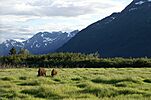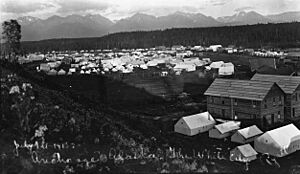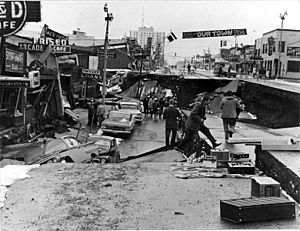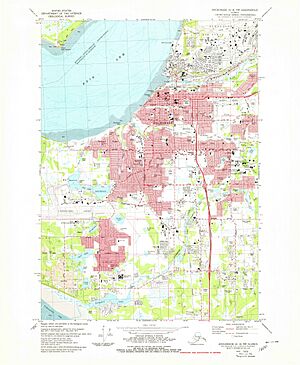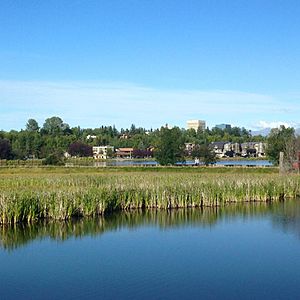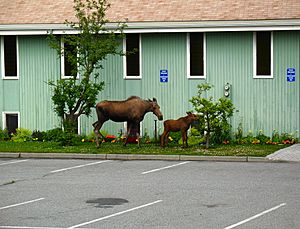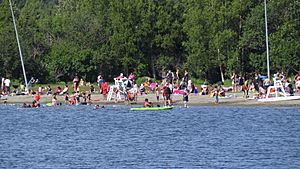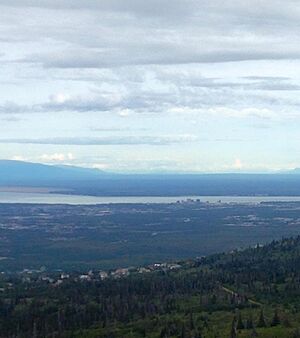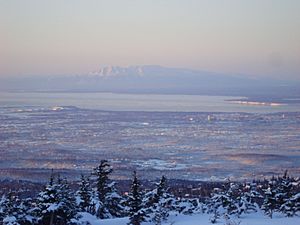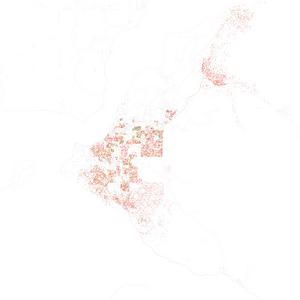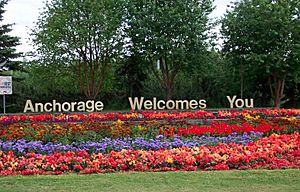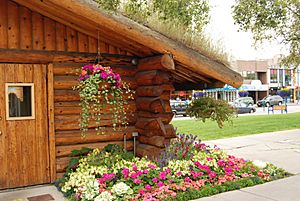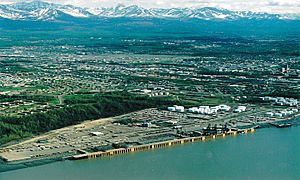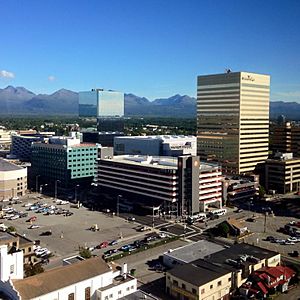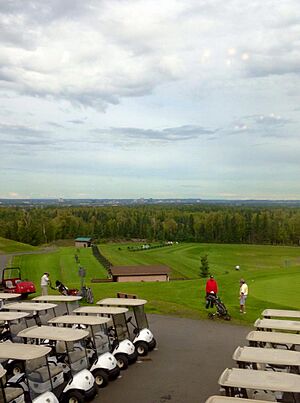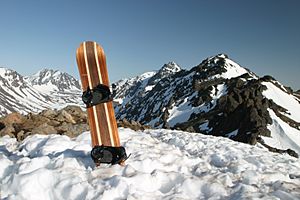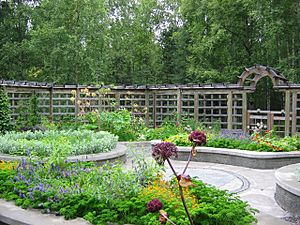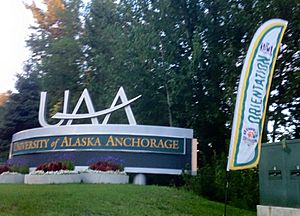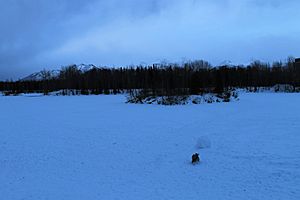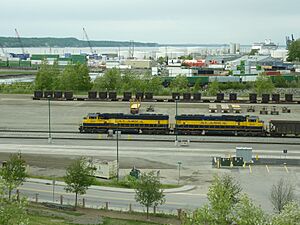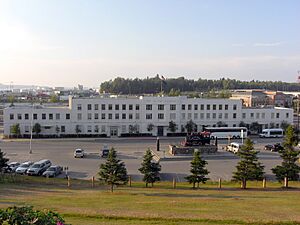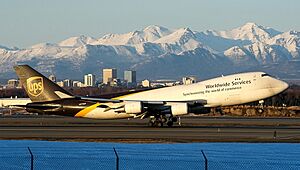Anchorage, Alaska facts for kids
Quick facts for kids
Anchorage
Dgheyay Kaq' (Tanaina)
|
|||
|---|---|---|---|
|
Consolidated city-borough
|
|||
| Municipality of Anchorage | |||
|
Anchorage Skyline with USS Anchorage departing
Alaska Native Heritage Center
Port of Alaska
|
|||
|
|||
| Nicknames:
"The City of Lights and Flowers", "Los Anchorage"
|
|||
| Motto(s):
Big Wild Life
|
|||
| Country | United States | ||
| State | Alaska | ||
| Borough | Anchorage | ||
| Settled | 1914 | ||
| Incorporated |
|
||
| Named for | The anchorage at the mouth of Ship Creek | ||
| Government | |||
| • Body | Anchorage Assembly | ||
| Area | |||
| • Consolidated city-borough | 1,946.69 sq mi (5,041.89 km2) | ||
| • Land | 1,706.89 sq mi (4,420.81 km2) | ||
| • Water | 239.80 sq mi (621.08 km2) | ||
| • Urban | 78.8 sq mi (204 km2) | ||
| Elevation | 102 ft (31 m) | ||
| Population
(2020)
|
|||
| • Consolidated city-borough | 291,247 | ||
| • Estimate
(2023)
|
286,075 |
||
| • Rank | |||
| • Density | 170.6/sq mi (65.88/km2) | ||
| • Urban | 249,252 (US: 164th) | ||
| • Urban density | 2,718.4/sq mi (1,049.6/km2) | ||
| • Metro | 398,807 (US: 137th) | ||
| Demonyms |
|
||
| GDP | |||
| • Consolidated city-borough | $27.809 billion (2022) | ||
| • Metro | $31.569 billion (2022) | ||
| Time zone | UTC-9 (AKST) | ||
| • Summer (DST) | UTC-8 (AKDT) | ||
| ZIP code |
99501–99524, 99529–99530, 99599
|
||
| Area code(s) | 907 | ||
| Geocode | 1398242 | ||
| FIPS code | 02-03000 | ||
| Climate | Dfc | ||
Anchorage is the largest city in Alaska, a state in the United States. About 291,247 people live here, based on the 2020 census. This means nearly 40% of everyone in Alaska lives in Anchorage! When you include the nearby Matanuska-Susitna Borough, the Anchorage area has over half of Alaska's population.
Anchorage is located in Southcentral Alaska. It sits on a piece of land between two waterways called the Knik Arm and the Turnagain Arm. The city started as a small camp in 1915 when workers began building the Alaska Railroad. It officially became a city in 1920. Later, in 1975, the city joined with the larger Anchorage area to form the "Municipality of Anchorage."
This city is very important for travel around the world. It's almost the same distance from New York City, Tokyo, and Murmansk, Russia. This means Anchorage is within a 10-hour flight of nearly 90% of the northern part of the world! Because of this, Ted Stevens Anchorage International Airport is a major stop for international cargo planes. It's also home to a big FedEx shipping center.
Anchorage has won the All-America City Award four times. This award celebrates cities that work together to solve problems. It has also been called the most tax-friendly city in the U.S. by Kiplinger.
Contents
History of Anchorage
Early People and Explorers
Archaeologists have found signs that people lived near Anchorage about 5,000 years ago. These were Alutiiq people who traveled by kayak. Later, other groups of Alutiiq people arrived. Around 500 AD, the Dena'ina Athabaskan people came to the area.
The Dena'ina people did not build permanent towns. They moved around with the seasons. In summer, they fished in rivers. In fall, they hunted animals like moose and gathered berries. In winter, they often stayed near trading spots. Here, they traded with other Dena'ina and Ahtna tribes.
Captain James Cook was one of the first European explorers to map the Alaskan coast. In 1778, he sailed into the area looking for a shortcut to the Pacific Ocean. He named many places, including "Ship Creek" and "Turnagain Arm." He realized this was not the shortcut he was looking for.
In the 1800s, Russians set up trading posts in South-Central Alaska. They also brought diseases like smallpox. These diseases greatly reduced the number of Native people living there.
Alaska Becomes Part of the U.S.
In 1867, the U.S. bought Alaska from Russia for $7.2 million. Some people thought this was a bad deal and called it "Seward's folly." But later, gold was found near Anchorage in 1888. This brought many gold seekers, and small towns started to grow.
Alaska became a U.S. territory in 1912. Unlike other big towns in Alaska, Anchorage didn't start as a fishing or mining camp. It grew because it was chosen as the starting point for building the Alaska Railroad in 1914.
The area near Ship Creek became a "tent city" where railroad workers lived. In 1915, the city was planned out on higher ground. Anchorage officially became a city on November 23, 1920.
Growth and Challenges
The Alaska Railroad was finished in 1923. For many years, the railroad was the main part of Anchorage's economy.
Between the 1930s and 1950s, Anchorage grew a lot. Air travel and military bases became very important. Merrill Field was the main airport until Ted Stevens Anchorage International Airport opened in 1951.
Elmendorf Air Force Base and Fort Richardson were built in the 1940s. These military bases were the main reason for the city's economy to grow.
The Great Alaska Earthquake
On March 27, 1964, a huge earthquake hit Anchorage. It was one of the biggest earthquakes ever recorded, with a magnitude of 9.2. The shaking lasted almost five minutes. Many buildings were damaged, and some areas of land collapsed because the soil turned to liquid. This event caused a lot of damage and led to rebuilding efforts throughout the 1960s.
Oil Boom and Modern Growth
In 1968, oil was found in Prudhoe Bay. This led to a big "oil boom" that helped Anchorage grow even more. In 1975, the City of Anchorage and the Greater Anchorage Area Borough merged. This created the larger Municipality of Anchorage we know today.
People have tried to move Alaska's state capital from Juneau to Anchorage several times. Most of Alaska's population lives near Anchorage. However, these attempts have not been successful. Even so, Anchorage is a major center for state and federal government activities in Alaska.
Geography of Anchorage
Anchorage is located in Southcentral Alaska. It is slightly north of cities like Oslo and Stockholm. The city sits on a coastal plain and extends up the lower slopes of the Chugach Mountains.
The city is on a peninsula. To the south is Turnagain Arm, a fjord with some of the world's highest tides. To the west and north is Knik Arm, another tidal inlet. The Chugach Mountains form a natural border to the east.
The coast of Anchorage has dangerous mudflats. People are warned not to walk on them because the tides change quickly, and the mud can trap you.
The Municipality of Anchorage covers a large area of about 1,961 square miles (5,079 square kilometers). Most of this area is land, but a significant part is water.
Cityscape and Views
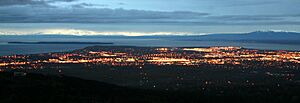

Wildlife in Anchorage
Anchorage is home to many different kinds of wildlife, even within the city!
- Bears: About 250 black bears and 60 grizzly bears live in the area. Bears are often seen in the city.
- Moose: These large animals are a common sight. In summer, about 250 moose live in the city, and in winter, this number can grow to 1,000. They can be dangerous to drivers, causing over 100 car accidents each year.
- Wolves: About 30 northern timber wolves live in the Anchorage area.
- Other Animals: You might also see beavers, foxes, and even lynxes.
- Beluga Whales: These whales are sometimes seen in the Turnagain Arm.
- Salmon: Many streams in the city have salmon runs, and fishing for salmon at Ship Creek is popular in summer.
Climate in Anchorage
Anchorage has a subarctic climate, but it's milder than other parts of Alaska because it's near the ocean. Most of the rain and snow falls in late summer.
- Summer: Average daytime temperatures are usually between 55°F (13°C) and 78°F (26°C). Summers are mild, but it can rain often.
- Winter: Average daytime temperatures are about 5°F (-15°C) to 30°F (-1°C). Anchorage gets a lot of snow, with an average of 75.5 inches (192 cm) each winter. The coldest temperature ever recorded was -38°F (-39°C) in 1947.
- Daylight: Because Anchorage is so far north, summer days are very long, and winter days are very short.
Volcanic Ash
Anchorage is near active volcanoes. Sometimes, ash from eruptions can fall on the city. For example, in 1992, Mount Spurr erupted and covered the city with about 3 millimeters of ash. This caused problems for the city's water system.
People of Anchorage
Population and Diversity
Anchorage is a diverse city. In 2020, the population was 291,247.
- 63.8% of people were White.
- 10.0% were Asian.
- 9.1% were American Indian or Alaska Native.
- 6.0% were African American.
- 8.4% were from two or more races.
- 9.4% of people were Hispanic or Latino (who can be of any race).
About 10.9% of the people in Anchorage were born outside the United States. In 17.8% of homes, a language other than English is spoken. The schools in Anchorage are known for being very diverse.
Economy of Anchorage
Anchorage's economy relies on several big industries:
- Transportation: This is a huge part of the economy.
- Military: There are large military bases here.
- Government: Many city, state, and federal government jobs are in Anchorage.
- Tourism: People visit Anchorage to see Alaska's beauty.
- Oil and Gas: Many oil companies have offices here.
Transportation Hub
The Ted Stevens Anchorage International Airport is one of the busiest airports in the world for cargo flights. This is because Anchorage is located on important flight paths between Asia and the rest of the U.S. It's a major hub for companies like FedEx.
The Port of Anchorage is also very important. It receives 95% of all goods that come into Alaska. This port is being updated to handle even bigger ships and be more resistant to earthquakes.
Military Presence
The U.S. military has two large bases that have been combined into one: Joint Base Elmendorf-Richardson (JBER). About 8,500 military and civilian workers are employed here. They, along with their families, make up about 10% of Anchorage's population.
Oil Industry
The oil industry is very important to Anchorage. Many large oil companies, like ConocoPhillips, have their main offices in downtown Anchorage. The Conoco-Phillips Building is even the tallest building in Alaska! While the oil is found in other parts of Alaska, Anchorage is where much of the business side happens.
No Sales Tax
Anchorage does not have a sales tax, which means you don't pay extra tax when you buy things. However, there is a tax on hotel stays and car rentals.
Arts and Culture
Anchorage has a lively arts scene.
- The Alaska Center for the Performing Arts hosts many shows, including Broadway musicals.
- The Anchorage Concert Association brings big performances to the city.
- The Anchorage Folk Festival happens every January, with concerts and workshops.
- The Sitka Summer Music Festival also has an "Autumn Classics" festival in September.
Museums and Centers
- Alaska Native Heritage Center: Learn about Alaska's Native cultures.
- Alaska Aviation Heritage Museum: See old airplanes and learn about flying in Alaska.
- Anchorage Museum at Rasmuson Center: A large museum with art, history, and science exhibits.
- Oscar Anderson House Museum: Visit a historic house from the early days of Anchorage.
- Wells Fargo Alaska Heritage Library & Museum: Learn about Alaska's history and banking.
Sports in Anchorage
Anchorage is a great place for sports, especially winter sports!
Dog Sledding
- Iditarod Trail Sled Dog Race: This famous race starts with a ceremonial kick-off in downtown Anchorage every March. It's a long race, over 1,000 miles!
- Fur Rendezvous Open World Championship Sled Dog Races: This is a shorter, faster dog sled sprint race held in February as part of the Fur Rendezvous winter carnival.
Other Sports
- Baseball: Anchorage has three teams in the Alaska Baseball League: the Anchorage Bucs, Anchorage Glacier Pilots, and Chugiak-Eagle River Chinooks.
- Hockey: The Anchorage Wolverines play in the North American Hockey League. The city used to have a very successful professional hockey team called the Alaska Aces.
- University Sports: The University of Alaska Anchorage (UAA) has college sports teams called the Seawolves. They have Division I teams in gymnastics and hockey.
- Skiing: Anchorage is a top city for cross-country skiing. It has over 105 miles (169 km) of groomed ski trails, some reaching downtown. The Tour of Anchorage is a 50-kilometer ski race held in the city.
Parks and Recreation
Anchorage has many beautiful parks and places to enjoy nature.
- Alaska Botanical Garden: See over 900 types of plants that can grow in cold climates.
- Alaska Zoo: Home to many animals, including those native to Alaska.
- Alaska Wildlife Conservation Center: A place to see and learn about Alaskan wildlife.
- Chugach State Park: A huge park with mountains, trails, and wildlife, partly within city limits.
- Kincaid Park: A large park with trails for skiing, biking, and walking.
- Tony Knowles Coastal Trail: A popular trail along the coast with great views.
- Flattop Mountain Recreation Area: A popular spot for hiking with amazing views of the city.
Many parks are connected by "green belts" that follow streams and lakes. This helps prevent floods and creates beautiful natural areas.
Education in Anchorage
Schools
Public schools in Anchorage are managed by the Anchorage School District. It's one of the largest school districts in the U.S., with nearly 50,000 students in 98 schools. There are also private schools available.
Colleges and Universities
Anchorage has several colleges where you can earn degrees:
- University of Alaska Anchorage
- Alaska Pacific University
- Charter College
- Wayland Baptist University (Anchorage campus)
About 90% of adults in Anchorage have a high school diploma, and many have attended college.
Media in Anchorage
Anchorage has its own newspaper, the Anchorage Daily News. There are also local TV channels like KTUU (NBC), KTBY (Fox), and KYUR (ABC). You can also find many radio stations in the city.
Transportation in Anchorage
Highways
Major highways in Anchorage are known by their names, not just numbers.
- The Seward Highway (AK-1) goes south from the city.
- The Glenn Highway (AK-1) goes northeast from the city.
- The Parks Highway (AK-3) branches off the Glenn Highway.
Public Transportation
Anchorage has a bus system called People Mover. It helps people get around the city. There's also a service called AnchorRides for seniors and people with disabilities.
Railroad
The Alaska Railroad offers freight service all year. During the summer, you can also take passenger trains to places like Fairbanks and Denali National Park.
Airports
The Ted Stevens Anchorage International Airport is the main airport for Alaska. Many national and international airlines fly here. It's also a huge hub for air cargo.
Next to it is Lake Hood Seaplane Base, the biggest seaplane base in the world! Merrill Field is another airport in the city, mainly for smaller planes.
Notable people
Sister cities
Anchorage has seven sister cities around the world:
 Chitose, Japan
Chitose, Japan Darwin, Australia
Darwin, Australia Harbin, China
Harbin, China Incheon, South Korea
Incheon, South Korea Magadan, Russia
Magadan, Russia Tromsø, Norway
Tromsø, Norway Whitby, United Kingdom
Whitby, United Kingdom
See also
 In Spanish: Anchorage para niños
In Spanish: Anchorage para niños
Images for kids



